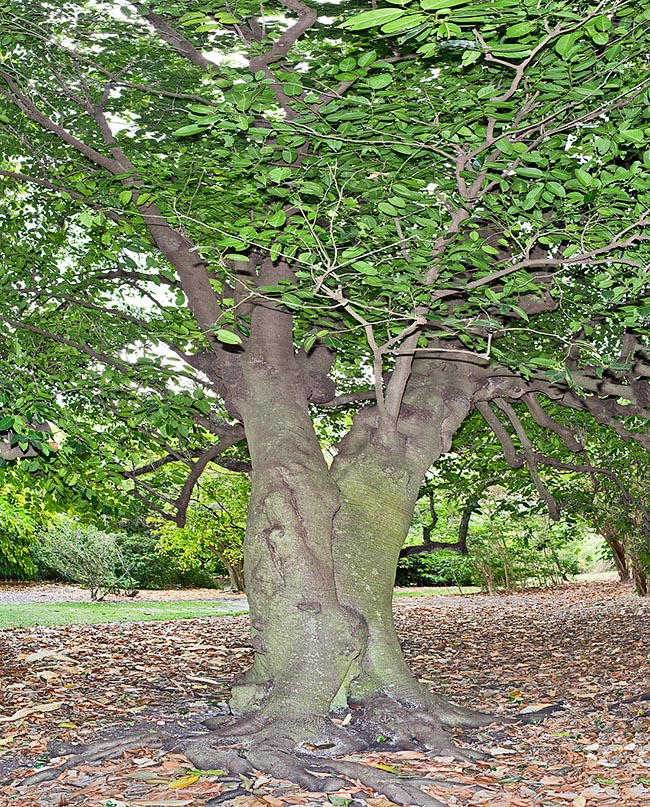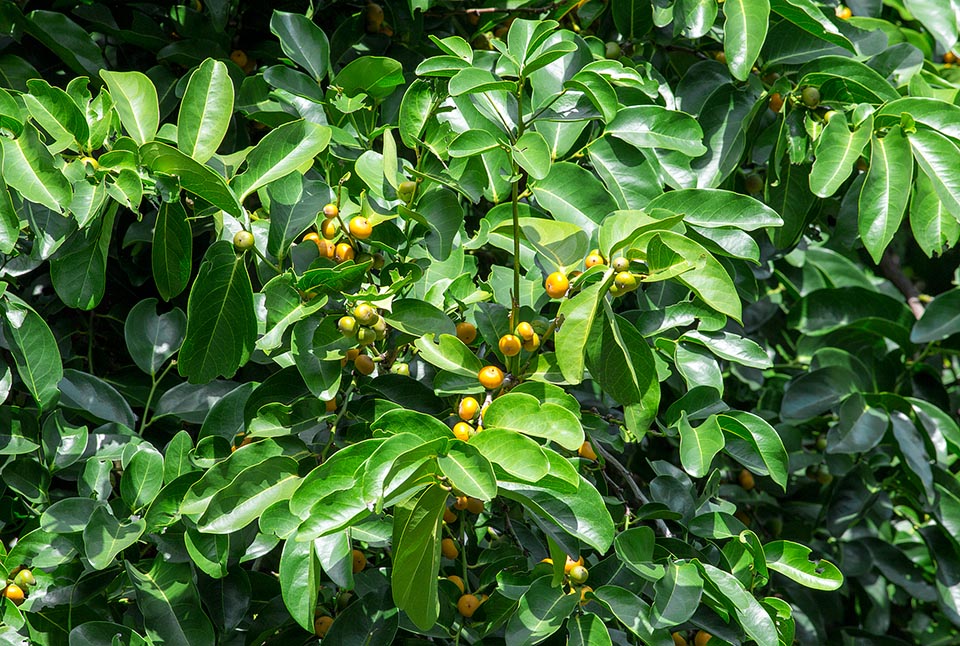Family : Ebenaceae

Text © Pietro Puccio

English translation by Mario Beltramini

Relative of the persimmon, the Diospyros maritima reaches in Soouth-East Asia the height of 15 m © Giuseppe Mazza
The species is native to Australia (Northern Territory, Queensland and Western Australia), Borneo, Japan (Nansei-shoto), Java, Lesser Sunda Islands, Maluku Islands, New Guinea, Philippines, Sulawesi, Sumatra and Taiwan where it lives in the coastal thickets and forest at low altitudes.
The name of the genus is the combination of the Greek adjective “διός” (diós) = divine and of the substantive “πυρός” (pyrós) = wheat, hence in a broad sense, ‘divine food’; the name of the species is the Latin adjective “maritimus, a, um” = maritime, marine, with reference to the coastal environment where it lives in the origin sites.
Common names: Malaysian persimmon, broad leaved ebony, sea ebony (English); hai bian shi (Chinese); kayu hitam (Indonesian); (Vietnamese).
The Diospyros maritima Blume (1826) is a shrub or an evergreen dioecious tree, 5-15 m tall, with trunk having a smooth greyish brown bark, tending to flake off in small quadrangular scales, and brown-yellowish young branches. The leaves, on a 0,6-1 cm long petiole, are simple, alternate, oblong-elliptical or obovate-oblong with obtusely acuminate apex and slightly wavy entire margin, 7-20 cm long and 3-9 cm broad, coriaceous, of glossy dark green colour above, opaque below, with paler central vein and prominent below. Fasciculate axillar male inflorescences with few flowers, on villous short pedicel, with tubular green calyx, pubescent externally, about 4 mm long, divided in 4 ovate erect lobes with acute apex, urceolate cream yellow corolla, pubescent externally, 8-9 mm tube with 4 oblong lobes having obtuse apex, about 7 mm long, and 16-20 stamens. Solitary sessile female flowers, axillar, similar to the male ones, with 8-locular ovary.
The fruit is a globose-depressed berry of yellow colour becoming orange-red when ripe, of 2-3 cm of diameter, with persistent calyx with retroflexed lobes, containing 7-8 seeds shaped like a clove, 1,2 cm long, of glossy blackish brown colour.
It propagates by seed, which has a short lasting duration of germinability, previously kept for one week in water renewed daily, placed in draining organic loam maintained constantly humid at the temperature of 24-28 °C, with germination times of 2-5 weeks, may reproduce also by cutting and layering.

The fruits are orange-yellow berries of 2-3 cm of diameter. The bark contains compounds with antibacterial, antifungal and cytotoxic activity © Giuseppe Mazza
Amply diffused along the coasts in the origin sites, but rarely present elsewhere, appears being able to adapt to be cultivated in the tropical and subtropical climate regions on various types of soil provided draining, slightly acidic to slightly alkaline, in full sun or light shade.
The wood, blackish, averagely light and of good quality, is locally utilized, and in part exported, for furniture and handicrafts in lieu of the most prized ebony varieties. Unknown are other particular uses by the local populations. Laboratory studies have evidenced in the bark the presence of various compounds with antibacterial, antifungal and cytotoxic activity that have aroused the interest of the official pharmacopoeia.
Synonyms: Cargillia laxa R.Br. (1810); Diospyros tetrandra Span. (1841); Cargillia maritima Hassk. (1844); Cargillia megalocarpa F.Muell. (1866); Maba megalocarpa F.Muell. (1866); Diospyros laxa (R.Br.) F.M.Bailey (1883); Diospyros liukiuensis Makino (1908); Diospyros kusanoi Hayata (1911); Diospyros camarinensis Merr. (1915); Diospyros nitens W.Fitzg. (1918); Diospyros maritima var. oblongata Bakh. (1941); Diospyros maritima var. ovalifolia Bakh. (1941).
→ To appreciate the biodiversity within the EBENACEAE family please click here.
